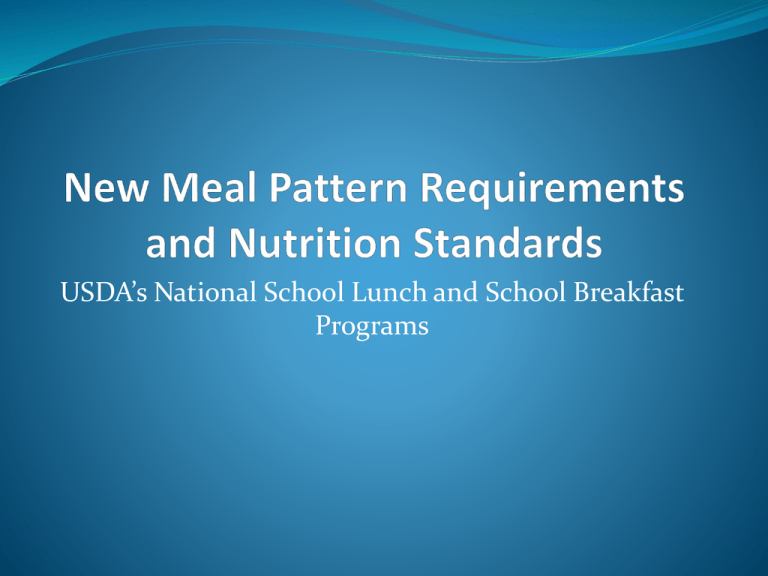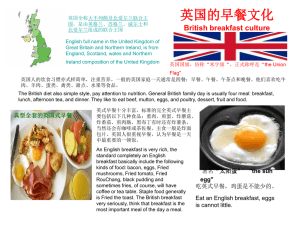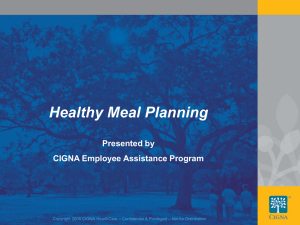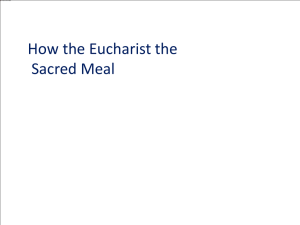New Meal Pattern Requirements and Nutrition
advertisement

USDA’s National School Lunch and School Breakfast Programs Agenda Welcome Training Overview New Meal Pattern – Meal Components Dietary Specifications Timelines for Implementation Key Issues and Questions Offer versus Serve Food Service Management Companies Program Monitoring Resources and Sharing Session USDA Foods Child Nutrition (CN) Labeling Program HealthierUS School Challenge (HUSSC) 2 Activities Case Study Applying some of the main points of today’s training as we go along. Top 10 list What are the top 10 things that must be implemented as of July 1, 2012? 3 Age/Grade Groups Same age/grade groups for NSLP and SBP: K-5 6-8 9-12 In the SBP, the change takes effect in SY 2013-2014 to ease burden on program operators 5 Menu Planning Approach Changes Food-Based Menu Planning approach for all age/grade groups NSLP operators must use FBMP beginning SY 2012-2013 SBP operators must use FBMP beginning SY 2013-14 6 Fruits Vegetables Grains Meat/Meat Alternate Milk 8 Lunch Meal Pattern Lunch Meal Pattern Grades K-5 Meal Pattern Grades 6-8 Grades 9-12 Amount of Fooda Per Week (Minimum Per Day) Fruits (cups)b 2.5 (0.5) 2.5 (0.5) 5 (1) Vegetables (cups)b 3.75 (0.75) 3.75 (0.75) 5 (1) Dark greenc 0.5 0.5 0.5 Red/Orangec 0.75 0.75 1.25 0.5 0.5 0.5 Starchyc 0.5 0.5 0.5 Otherc,d 0.5 0.5 0.75 Beans and peas (legumes)c Additional Veg to Reach Totale 1 1 1.5 Grains (oz eq) f 8-9 (1) 8-10 (1) 10-12 (2) Meats/Meat Alternates (oz eq) 8-10 (1) 9-10 (1) 10-12 (2) 5 (1) 5 (1) 5 (1) Fluid milk (cups) g Other Specifications: Daily Amount Based on the Average for a 5-Day Week Min-max calories (kcal)h Saturated fat (% of total calories)h Sodium (mg)h,i Trans fath 550-650 600-700 750-850 < 10 < 10 < 10 < 640 < 710 < 740 Nutrition label or manufacturer specifications must indicate zero grams of trans fat per serving. 9 Fruits (Lunch) Lunch Meal Pattern Grades K-5 Meal Pattern Grades 6-8 Grades 9-12 Amount of Foodb Per Week (Minimum Per Day) Fruits (cups) 2.5 (0.5) 2.5 (0.5) 5 (1) 10 Fruits (Lunch) Fruits/vegetables separated into two components A daily serving at lunch May select from fresh, frozen without added sugar, canned in juice/light syrup, or dried fruit options No more than half of fruit offerings may be in the form of juice 100% juice only ¼ cup of dried fruit = ½ cup of fruit Refer to Food Buying Guide for crediting 11 Vegetables (Lunch) Lunch Meal Pattern Grades K-5 Meal Pattern Vegetables (cups) Grades 6-8 Grades 9-12 Amount of Food Per Week (Minimum Per Day) 3.75 (0.75) 3.75 (0.75) 5 (1) 0.5 0.75 0.5 1.25 • Dark green • Red/Orange 0.5 0.75 • Beans/Peas (Legumes) 0.5 0.5 0.5 0.5 0.5 0.5 0.5 0.5 0.75 1 1 1.5 • Starchy • Other Additional Veg to Reach Total 12 Vegetables (Lunch) A daily serving that reflects variety over the week Vegetable subgroup weekly requirements for: Dark Green (e.g., broccoli, collard greens, spinach) Red/Orange (e.g., carrots, sweet potatoes, tomatoes) Beans/Peas (Legumes) (e.g., kidney beans, lentils, chickpeas) Starchy (e.g., corn, green peas, white potatoes) Other (e.g., onions, green beans, cucumbers) Additional vegetables to meet 5 cup weekly total 13 Vegetables (Lunch) Variety of preparation methods available Fresh, frozen, and canned products USDA Foods offers a variety of no salt added or lower sodium products Changes in crediting of leafy greens Foods from the beans/peas (legumes) subgroup may be credited as a vegetable OR a meat alternate 14 Grains (Lunch) Lunch Meal Pattern GradesK-5 Meal Pattern Grains (oz eq) Grades6-8 Grades9-12 Amount of Foodb Per Week (Minimum Per Day) 8-9 (1) 8-10 (1) 10-12 (2) 15 Grains (Lunch) Schools must offer the daily and weekly serving ranges of grains Maximums and minimums Initially, at least ½ of grains offered during the week must be whole grain-rich Beginning in SY 2014-15, all grains offered must be whole grain-rich “Whole grain-rich” foods must contain at least 50 percent whole grains 16 Grains (Lunch) Grain-Based Desserts Only two creditable grain-based desserts allowed at lunch per school week These items are a major source of solid fats and added sugars per DGA 2010 17 Criteria for Whole Grain-Rich Foods Meet the serving size requirements in the Grains/Breads Instruction, and Meet at least one of the following: Whole grains per serving must be ≥ 8 grams Product includes FDA’s whole grain health claim on its packaging Product ingredient listing lists whole grain first (HUSSC criteria) 18 Meats/Meat Alternates (Lunch) Lunch Meal Pattern Grades K-5 Meal Pattern Meats/Meat Alternates (oz eq) Grades 6-8 Grades 9-12 Amount of Food Per Week (Minimum Per Day) 8-10 (1) 9-10 (1) 10-12 (2) 19 Meats/Meat Alternates (Lunch) Daily and weekly requirements for lunch only 2 oz eq. daily for students in grades 9-12 1 oz eq. daily for younger students A variety of meat/meat alternates is encouraged Tofu and soy yogurt will be allowable as meat alternate See memo SP-16-2012, Crediting Tofu and Soy Yogurt Products 20 Milk (Lunch) Lunch Meal Pattern Grades K-5 Meal Pattern Fluid milk (cups) l Grades 6-8 Grades 9-12 Amount of Food Per Week (Minimum Per Day) 5 (1) 5 (1) 5 (1) 21 Milk (Lunch) Allowable milk options: Fat-free (unflavored or flavored) Low-fat (unflavored only) Fat-free or low-fat (lactose-reduced or lactose-free) Must offer at least two choices Does not alter nutrition standards for milk substitutes (e.g., soy beverages) Milk provisions also apply to children ages 3-4 22 Fruits Grains Milk Breakfast Meal Pattern Breakfast Meal Pattern Grades 6-8 Grades K-5 Meal Pattern Fruits (cups)b Grades 9-12 Amount of Fooda Per Week (Minimum Per Day) 5 (1) e 5 (1) e 5 (1) e Vegetables (cups)b 0 0 0 Dark greenc 0 0 0 Red/Orangec 0 0 0 Beans and peas (legumes)c 0 0 0 Starchyc 0 0 0 Otherc,d 0 0 0 Additional Veg to Reach Totale 0 0 0 Grains (oz eq) f 7-10 (1) Meats/Meat Alternates (oz eq) 0k 0k 0k Fluid milk (cups) g 5 (1) 5 (1) 5 (1) j 8-10 (1) j 9-10 (1) j Other Specifications: Daily Amount Based on the Average for a 5-Day Week Min-max calories (kcal)h Saturated fat (% of total calories)h Sodium (mg)h,i Trans fath 350-500 400-550 450-600 < 10 < 10 < 10 < 470 < 500 < 430 Nutrition label or manufacturer specifications must indicate zero grams of trans fat per serving. 25 Fruits (Breakfast) Breakfast Meal Pattern Grades K-5 Meal Pattern Fruits (cups) Grades 6-8 Grades 9-12 Amount of Food Per Week (Minimum Per Day) 5 (1) 5 (1) 5 (1) 26 Fruits (Breakfast) Fruits is a single component A daily serving must be offered at breakfast At breakfast only, vegetables may be offered in place of fruits 27 Grains (Breakfast) Breakfast Meal Pattern Grades K-5 Meal Pattern Grains (oz eq) Grades 6-8 Grades 9-12 Amount of Food Per Week (Minimum Per Day) 7-10 (1) 8-10 (1) 9-10 (1) 28 Grains (Breakfast) Offer the daily and weekly serving ranges of grains at breakfast Phased-in implementation of whole grain-rich Schools may substitute meat/meat alternate for grains once daily grains minimum is met 29 Milk (Breakfast) Breakfast Meal Pattern Grades K-5 Meal Pattern Fluid milk (cups) Grades 6-8 Grades 9-12 Amount of Food Per Week (Minimum Per Day) 5 (1) 5 (1) 5 (1) 30 Fluid Milk (Breakfast) Allowable milk options include: fat-free (unflavored or flavored) low-fat (unflavored only) fat-free or low-fat (lactose-reduced or lactose-free) Must offer at least two choices Does not alter nutrition standards for milk substitutes (e.g., soy beverages) Students may decline milk component under OVS 31 Four Dietary Specifications Weekly average requirements Calories Sodium Saturated fat Daily requirement Trans fat 34 Calorie Ranges Minimum and maximum calorie (kcal) levels Average over course of the week Effective SY 2013-14 for SBP Effective SY 2012-13 for NSLP Grade Level: K-5 (ages 5-10) Calorie Ranges: Breakfast: 350-500 Lunch: 550-650 Grade Level: 6-8 (Ages 11-13) Calorie Ranges: Breakfast: 400-500 Lunch: 600-700 Grade Level: 9-12 ( Ages 14-18) Calorie Ranges: Breakfast: 450-600 Lunch: 750-850 35 Sodium Sodium Limits and Timeline Target 1: SY 2014-15 Target 2: SY 2017-18 Final target: SY 2022-23 Lunch ≤1230mg (K-5) ≤1360mg (6-8) ≤1420mg (9-12) Lunch ≤935mg (K-5) ≤1035mg (6-8) ≤1080mg (9-12) Lunch ≤640mg (K-5) ≤710mg (6-8) ≤740mg (9-12) Breakfast ≤485mg ( K-5) ≤535mg (6-8) ≤570mg (9-12 Breakfast ≤430mg ( K-5) ≤470mg (6-8) ≤500mg (9-12) Breakfast ≤540mg ( K-5) ≤600mg (6-8) ≤640mg (9-12 36 Sodium Reduction Efforts Procurement specifications and recipes will have to be modified Technical assistance and training resources will be available USDA Foods reducing sodium in foods available to schools Already reduced for products such as most cheeses 37 Saturated Fat Limit saturated fat Less than 10 percent of total calories Same as current regulatory standard No total fat standard 38 Trans Fat New trans fat restriction Nutrition label or manufacturer’s specifications must specify zero grams of trans fat per serving (less than 0.5 gram per serving) Begins SY 2013-2014 for SBP Begins SY 2012-2013 for NSLP Naturally-occurring trans fat excluded e.g. beef, lamb, dairy products 39 Implementation Timeline NEW REQUIREMENTS FRUITS COMPONENT Offer fruit daily Fruit quantity increase to 5 cups/week (minimum 1 cup/day) VEGETABLES COMPONENT Offer vegetables subgroups weekly GRAINS COMPONENT Half of grains must be whole grain-rich All grains must be whole-grain rich Offer weekly grains ranges MEATS/MEAT ALTERNATES COMPONENT Offer weekly meats/meat alternates ranges (daily min.) MILK COMPONENT Offer only fat-free (unflavored or flavored) and low-fat (unflavored) milk DIETARY SPECIFICATIONS (to be met on average over a week) Calorie ranges Saturated fat limit (no change) Sodium Targets l-Target 1Target 2Final target Zero grams of trans fat per portion MENU PLANNING A single FBMP approach AGE-GRADE GROUPS Establish age/grade groups: K-5, 6-8, and 9-12 OFFER VS. SERVE Reimbursable meals must contain a fruit or vegetable (1/2 cup minimum) MONITORING 3-year adm. review cycle Conduct weighted nutrient analysis on 1 week of menus Implementation (School Year) for NSLP (L) and SBP (B) 2012/13 2013/14 2014/15 2015/16 2016/17 2017/18 2022/23 L, B L, B L B L L B L B L, B L L, B L L, B B L B L B L B L, B L B L, B L B 41 Lunch Program Changes All changes to lunch go into effect July 1st, 2012 with the following exceptions: 3-year administrative review cycle (July 1st, 2013) All grains must be whole grain-rich (July 1st, 2014) First target (#1) for average weekly sodium limit (July 1st, 2014) Target 2 goes into effect for SY 2017-2018 Final Target goes into effect for SY 2022-2023 42 Breakfast Program Changes SY 2012-13 No changes to breakfast effective July 1st, 2012 Schools continue with current meal pattern/menu approaches Exceptions: Milk requirement, which is already in effect (fat & flavor) Formulated grain-fruit products not creditable 43 Breakfast Program Changes SY 2013-14 New meal pattern goes into effect, with the following exceptions: Fruit/vegetable component with current (existing) required quantities remains this year No sodium limit yet 44 Breakfast Program Changes SY 2014-15 Schools continue to follow the new meal pattern All grains whole grain-rich Fruit/vegetable component becomes a Fruit component only, quantities increase New OVS requirements for breakfast apply First target (#1) for average weekly sodium limit (July 1st, 2014) Target 2 goes into effect for SY 2017-2018 Final Target goes into effect for SY 2022-2023 45 Key Issues and Questions Identification of reimbursable meal Early adoption of breakfast requirements Existing Inventory (frozen fruit) Fruit and vegetable serving sizes Vegetables in the SBP Grains- whole grain-rich criteria Formulated grain-fruit products Tofu and soy products Milk Sodium Sodium reduction techniques Trans fat 47 Identification of reimbursable meal Identify content of reimbursable lunch and breakfast near or at the beginning of the serving line(s) Assures students do not unintentionally purchase a la carte items, minimize issues at point of sale Schools have discretion how to identify these foods Discretion depends on set up, age of children, etc 48 Early adoption of breakfast requirements Breakfast requirements are being phased in over several years Designed to reduce operator burden However, some SFAs may prefer to adopt changes to NSLP and SBP concurrently SFAs must seek permission by States to implement new standards earlier than required Serves as additional checkpoint to maintain nutritional integrity 49 Existing Inventory (Frozen Fruit) Relatively few items cannot be used in SY 2012-13 Careful menu planning Use in other programs (SFSP, Snack Program) Frozen fruit without added sugar Exemption for SY 2012-13 only Applies to USDA Foods and commercially purchased products SP 20-2012, issued Feb 24th 50 Fruits/Vegetables – Serving Sizes Serving Size – What needs to be provided? ⅛ cup? ¼ cup? ½ cup? More? Any of the above can work if you have enough of each option 51 Vegetables in SBP 1 cup daily fruit requirement effective July 1, 2014 Vegetables may be substituted for fruit Starchy vegetables may be served if two cups of vegetables from the dark green, red/orange, legumes, and/or other subgroup have also been offered 52 Grains: Whole Grain-Rich Whole-Grain Rich = at least 50% whole grains Dietary Guidelines update If the first ingredient is water, a whole grain may be listed as the second ingredient and still meet our whole grain-rich criteria 53 54 Grains: Formulated grain-fruit What is a formulated grain-fruit product? A grain product Highly fortified Creditable as both a grain and fruit serving Required specific FNS approval This change does not prohibit: Energy, granola, cereal, or breakfast bars (with or without fruit pieces or spread) Fortified cereal or cereals with fruit pieces 55 Tofu and Soy Products Crediting Tofu Must be commercially prepared Must meet definition est. in 7 CFR 210.2 2.2 ounces (1/4 cup) of commercially prepared tofu, containing at least 5 grams of protein, is creditable as 1.0 oz. eq. meat alternate. ½ cup (4 fluid oz) is creditable as 1.o oz. eq. meat alternate Memo SP 16 – 2012, “Crediting Tofu and Soy Yogurt Products,” dated Feb. 22, 2012 56 Sodium Naturally occurring sodium (i.e. milk) and nutrient analysis 57 Sodium Reduction Techniques Increase in-house preparation, scratch cooking USDA foods Menu planning Procurement specifications Nutrition labels Condiments Alternate seasoning choices Salt shakers/packets on the tables 58 Trans Fat- Mixed Dishes Products containing naturally-occurring trans fat and possibly added trans fat Schools must request this information from vendors Vendors already moving away from use of trans fats in products 59 Key Issues (Menu Planning Considerations) Age/Grade groups Pre-K/CACFP/Snack programs Short and long weeks Whole-grain rich offerings Multiple offerings and serving lines Salad bars Daily minimums Vegetable subgroups Weekly ranges (min/max) 61 Age/Grade Groups Overlap in K-5 and 6-8 meal patterns A single menu can meet both patterns Must meet following: 8-9 oz eq grains/week 9-10 oz eq meats/meat alternates/week Average daily calorie range 600-650 Average daily sodium limit ≤640 mg* *Note this is final sodium target; no sodium requirement until SY 2014-15 62 Age/Grade Groups (cont’d) No overlap in grades 6-8 and 9-12 meal patterns Schools that consist of both grade-groups must develop menus accordingly to meet needs of these two separate groups Previously, schools allowed a one grade level deviation No allowance for this in new meal pattern 63 Example of Age/Grade Group Differences Grade Level: K-5 (ages 5-10) Grade Level: 6-8 (Ages 11-13) Grade Level: 9-12 ( Ages 14-18) Calorie Ranges: Breakfast: 350-500 Lunch: 550-650 Calorie Ranges: Breakfast: 400-500 Lunch: 600-700 Calorie Ranges: Breakfast: 450-600 Lunch: 750-850 Overlaps B: 400-500 L: 600-650 Overlaps B: 450-500 L: --64 Menu Planning for Grades 6-8 and 9-12 Modest adaptations to menus to accommodate needs of older children: Offer ½ cup more fruit daily Offer ¼ cup more vegetables daily Need ½ cup more red/orange, ¼ cup other, ½ cup additional (any subgroup) some time during the week These changes alone may meet calorie needs for the 9-12 group Consider an additional oz eq of grain and/or M/MA for the older kids 65 Menu Planning Activity: Grade Groups 66 Pre-K/CACFP/Snack Programs New school meal patterns not required Schools encouraged to make healthier changes provided in new rule Proposed CACFP rule may make changes to these groups Milk fat restriction (1% or less) does apply to these programs (but not SFSP) 67 Short and Long Weeks General approach is to increase or decrease required weekly quantities by 20% for each day variation from a standard 5-day week Weeks with 1 or 2 days may be combined with either the previous or following week Daily requirements apply regardless of week length 68 Short and Long Weeks- Examples Based on Lunch Meal Pattern for K-5 Selected components/dietary specifications K-5 Lunch Meal Pattern Meal Pattern 5-day week 4-day week 7-day week Fruits (cups) 2.5 (0.5) 2.0 (0.5) 3.5 (0.5) Grains (oz eq) 8-9 (1) 6.5-7.5 (1) 11-12.5 (1) Min-max Calories (kcal) 550-650 550-650 550-650 69 Whole Grain-Rich From the preamble of the rule: For lunch in 2012-14 and breakfast in 2013-14, “…schools must offer the weekly grain ranges and half of the grains as whole grain-rich” Semantics Half of the required ounce equivalents must be whole grain-rich 70 Whole Grain-Rich Operational considerations Option 1: Schools show they are offering half of the total ounce equivalents for the week are whole grainrich Option 2: Schools show they are EITHER offering half of their items as whole grain-rich OR half of the total ounce equivalents for the week are whole grain-rich 71 Whole Grain-Rich Questions Question #1 Do all grain items have to be whole grain-rich? 72 Whole Grain-Rich Questions Question #1 Do all grain items have to be whole grain-rich? NO. Half of the grains must be whole grain-rich, and the other half may be enriched (not whole grain-rich)- until SY 2014-15 73 Whole Grain-Rich Questions Question #2 Do schools have to offer a daily whole grain-rich item? 74 Whole Grain-Rich Questions Question #2 Do schools have to offer a daily whole grain-rich item? NO. This is a weekly requirement. 75 Multiple Offerings and Serving Lines Regulatory Requirement Salad Bars Daily minimums Discussion Vegetable subgroup weekly minimums Weekly ranges (max/min) Discussion 76 Multiple Offerings and Serving Lines (cont’d) Regulatory Requirement “Schools that offer a variety of lunches or multiple serving lines must make all required food components available to all students, on every lunch line, in at least the minimum required amounts” 210.10(k)(2) on page 4147 in Federal Register More detailed guidance to come (definitions of distinct serving lines, etc.) 77 Salad Bars Excellent way to offer variety of vegetables If a separate serving line, must offer all components of a reimbursable meal All daily and weekly requirements must be met For vegetable subgroups, schools must offer, but child does not have to take subgroups Variety within subgroups encouraged but not required Suggestions for using salad bars http://teamnutrition.usda.gov/Resources/tricks_trade.pdf Know the planned portion sizes Pre-portion some foods Use portion-controlled serving utensils 78 Multiple Offerings and Serving Lines (cont’d) Daily minimum requirements Students must select the minimum daily requirement to meet any single meal component All offerings must meet the minimum requirement 79 Multiple Offerings and Serving Lines (cont’d) Compliance Approach Discussion Average of all daily offerings are in compliance OR All offerings of the food groups be equal to or above the daily minimum requirements 80 Multiple Offerings and Serving Lines (cont’d) Vegetable subgroup weekly requirements No daily subgroup requirement What if a school only serves two of the weekly subgroups on one day (the same day) and the student may choose only one of these? Need to make the affected subgroups available for student selection on an additional day Lots of training and technical assistance needed to prevent/correct this 81 Multiple Offerings and Serving Lines (cont’d) Food Item Portion size Chili con carne with beans Chicken Caesar entree salad 1 cup 1 salad (2 cups romaine lettuce, 3 oz grilled chicken) 1 taco (2.5 oz pita, 2 oz grilled chicken, iceberg lettuce topping) Soft taco with chicken Food Item Broccoli Pinto beans Vegetable Subgroup Contribution 1/2 cup legumes 1 cup dark green vegetables N/A Portion size/ Vegetable Subgroup 1/2 cup dark green vegetables 1/2 cup legumes 82 Vegetable Subgroup Decision Tree Does daily menu include two vegetable subgroups? Yes No Is either subgroup offered another day? Yes No No Conflict How are the vegetables offered? Both as vegetable choice Both as part of entrée In different entrees? Yes Conflict No Conflict No No Conflict One as part of entrée, one as vegetable choice Can select only one? Yes Conflict No Conflict No No Conflict 83 Multiple Offerings and Serving Lines (cont’d) Weekly range (min/max) requirements Grains and meat/meat alternates Sum of daily minimums must meet the weekly minimum requirement Sum of daily maximums must not exceed the weekly maximum requirement 84 Multiple Offerings and Serving Lines (cont’d) Compliance Approach Discussion Sum of daily minimums must meet the weekly minimum requirement AND sum of daily maximums must meet the weekly maximum requirement OR Sum of daily averages to be compliant with the weekly min and max 85 Discussion Whole Grain-Rich offerings Consider: half items OR half ounce equivalents each week are WGR Daily minimums All offerings be equal to or above daily minimum requirement, OR average of offerings are at or above minimum Weekly ranges (min/max) Other Key Issues discussed here Others? 86 87 88 89 OVS - What Didn’t Change Only required for senior high schools for the NLSP Optional for lower grades for the NSLP Optional for the SBP at all grade levels 90 OVS - What Didn’t Change Student’s option to decline item(s) Same price if child declines item(s) Full amount of each component must be available to choose 91 Definitions Food component— One of five food groups for reimbursable meals Food item— A specific food offered within the five food components. 92 What must be offered in NSLP 5 components Meat/meat alternate Grains Fruits Vegetables Milk 93 Lunch Example The lunch offered: turkey, mashed potatoes, peaches, roll and milk OVS—current Turkey, roll and milk = reimbursable lunch OVS-under new regulations Turkey, roll and milk ≠ reimbursable lunch To be reimbursable, must add mashed potatoes or peaches 94 OVS for NSLP--What must be taken Must take at least 3 of 5 components Must take at least ½ cup serving of the fruit or vegetable component Student may take two ¼ cup servings of the same item fruit or vegetable to meet the requirement 95 Different Choices Can mix different fruits to reach minimum required serving Can mix different vegetables to reach minimum required serving 96 OVS for SBP Phasing-in changes in the SBP For SY 2012-2013, no changes to SBP other than milk requirement For SY 2012-2013, may continue to use current menu planning approach and requisite OVS requirements 97 SBP for SY 2013-2014 Must offer 3 components without OVS Grains (optional meat/meat alternate after daily grain met) Fruit/Vegetable/Juice (current quantities) Milk Must offer 4 food items if using OVS Grains Fruit/Vegetable/Juice Milk Additional item 98 SBP for SY 2014-2015 Fruit component only Quantity of fruit required increases Vegetables may be substituted to provide all or part of the fruit requirement For OVS, must take at least- ½ cup of fruit OR ½ cup of vegetable, if offered 99 What must be offered for SBP 3 components Grains (optional meat/meat alternate substitution) Fruits (optional vegetable substitution) Milk OVS must offer four food items Milk Fruit (or optional vegetable) Grains One additional item 100 OVS for SBP-What must be taken Students may decline one item except they must take at least ½ cup of fruit OR ½ cup of vegetable, if offered 101 An OVS Challenge 103 Monitoring Requirements Interim Rule – 6 Cent Certification Final Meal Pattern Rule 3 year State agency review cycle Begins School Year 2013-14 (July 1, 2013) Admin review includes breakfast beginning SY 2013-14 SMI reviews eliminated Modified Performance Standard 2 (CRE) Nutrition Provisions 104 Monitoring Requirements (cont.) Performance Standard 2 requirements Lunch and breakfast Food components and quantities State agency weighted nutrient analysis on meals offered to determine compliance with calories, sodium, saturated fat State review of nutrition labels and/or manufacturer specs for trans fat 105 Technical Assistance and Corrective Action Actions required for Performance Standard 2 Violations Missing Menu Items/Food Items • Immediate fiscal action required (as currently done) Milk Type, and Vegetable Subgroup • Fiscal action required for unresolved, repeat violations (after technical assistance and corrective action have taken place) Whole Grain Rich, Food Quantities, and Dietary Specifications • State Agencies have discretion to take fiscal action for unresolved, repeated violations (after technical assistance and corrective action have taken place) 106 Monitoring Workgroup Administrative Review Reinvention Team will consider administrative review process and procedures Not bound by what’s currently in place---will look at program requirements and make recommendations for how best to achieve program oversight Develop new tools to accomplish review activity 107 Monitoring/Oversight Timeline Spring 2012 Interim rule: certification for 6 cent reimbursement Additional information on SY 2012-13 administrative reviews Begin reinvention of administrative reviews SY 2012-2013 New meal patterns implemented for lunch (July 1, 2012) Certification for 6 cents (funds available 10/1/12) Final year of current 5-year review cycle for CRE No SMIs SY 2013-2014 3-year cycle for administrative reviews begins 108 State Funding Assistance • Funding from HHFKA for the first two years of the new meal requirements • • To assist SAs with implementing new requirements Expected increases in State Administrative Expense funding in two years • Based on increased reimbursement with additional 6 cents 109 Contracting with Food Service Management Companies 110 Policy memo issued by FNS SP 17-2012 issued on February 23, 2012 Title: “Procurement Questions and Answers to Assist in the Implementation of the final rule titled Nutrition Standards in the National School Lunch and School Breakfast Programs” 111 Impact of final rule on SFA-FSMC contracts? We anticipate that some current contracts between SFAs and FSMCs will not be inconsistent with the new nutrition standards of the final rule; therefore, those contacts would require only nonmaterial changes to ensure consistency with the final rule This means that some SFAs may have anticipated the new nutrition standards and their current contracts will require nonmaterial changes to ensure consistency with the final rule. 112 How do SFAs determine if the implementation of the final rule will create a material change to current SFA-FSMC contracts? SAs and SFAs must review existing contracts to determine if implementation of the final rule (i.e., new meal pattern requirements) will result in material changes to current contracts A blanket answer is not acceptable as the determination depends on the initial solicitation and resulting contract (unique for each SFA-FSMC contract) 113 Questions to ask to help determine material change If there would be an increase or decrease to the cost of the contract, would the increase or decrease in cost have caused bidders to bid differently if the prospective change had existed at the time of bidding? Would the prospective change materially affect the scope of services, types of food products, volume of food products, etc., in both the solicitation document and resulting contract? For example, the final rule requires schools to serve whole- grain rich products, and specific varieties of vegetables, which already may be included in current contracts 114 Note: renewals are not automatic Per regulations, contracts between SFAs and FSMCs must be no longer than one year in duration with four optional annual renewals Every SFA should annually reviewing its FSMC contract with no expectation by either party to renew the contract SA and SFA must review the current contract and determine if any prospective changes would result in a material change 115 What options are available if SFA’s implementation of final rule creates a material change to contract with FSMC? Option 1: SFA can conduct a separate procurement to obtain the desired deliverable that created the material change For example, the current contract doesn’t address whole-grain rich foods. SFA would issue a solicitation to procure additional whole-grain rich foods, consistent with the current contract between SFA and FSMC 116 What options are available if SFA’s implementation of final rule creates a material change to contract with FSMC? contd. Option 2: SFA can conduct a new procurement (i.e., rebid) and ensure that the new solicitation associated with the rebid contains the appropriate specifications and provision to ensure conformance to the final rule For example, if the SFA’s initial solicitation and resulting contract did not address whole-grain rich foods, the SFA would ensure that rebid specifications would procure such foods. 117 What happens if rebid can’t be completed prior to 2013-14 SY? If a rebid is deemed necessary based on the implementation of the final rule, the SFA may in the interim amend its current contract in order to ensure full implementation of the final rule until the rebid could occur All rebids must occur prior to the 2013-14 SY Both the SFA and FSMC would need to agree to the terms of the amendment 118 What if FSMC doesn’t agree to amending current contract? The SFA would need to take immediate action. For example, immediate action may include: Termination of the current contract between the SFA and the FSMC in accordance with the termination provisions and issuance of a new solicitation; Issuance of a separate solicitation to procure the necessary foods in order to ensure compliance with the final rule, consistent with the current contract between the parties 119 Timeline for new procurement (i.e., rebid)? An SFA may conduct a procurement at the next feasible juncture if needed; However, SAs and SFAs must ensure that a new procurement is completed for the 2013-14 school year (SY) This means that a new procurement (i.e., rebid) must be completed for the 2013-14 SY. 120 What about other contracts (i.e., SFA contracts with distributor)? The same principles and timeframes should apply to all SFA contracts 121 Additional guidance Will continue to review your questions and concerns Additional guidance as well as modifications to existing guidance, as needed, will be forthcoming 122 Menu Planning Resources for the New Meal Pattern Menu Planning Resources for the New Meal Pattern Objective: Upon completion of this session the listener will be able to: Identify resources to provide technical assistance to School Food Authorities on menu planning for the New Meal Pattern and the Dietary Guidelines. 124 Menu Planning Resources for the New Meal Pattern What resources will be available to assist with Menu Planning for the New Meal Pattern? 125 Team Nutrition Resources teamnutrition.usda.gov 126 127 Update the Food Buying Guide www.fns.usda.gov/tn/Resources/foodbuyingguide.html 128 Food Buying Guide Calculator fbg.nfsmi.org 129 Menu Planner for Healthy School Meals 130 Coming Summer 2012… Updated Fact Sheets 131 132 Available now from Team Nutrition Make Half your Plate Fruits & Vegetables Poster 133 Available now from Team Nutrition Fruits and Vegetables Galore: Helping Kids Eat More 134 HealthierUS School Challenge Resources 135 136 HealthierUS School Challenge Resources 137 HealthierUS Whole Grain Resource http://www.teamnutrition.usda.gov/HealthierUS/HUSSCkit_pp25-35.pdf 138 HealthierUS Whole Grain Resource 139 Timeline for Updated Resources Food Buying Guide in Sections – Spring, 2012 - Separating Fruits and Vegetable Subgroups and editing to include tofu, soy yogurt, lower fat milk Winter 2013 - Yield studies for new food items and Whole Grain products Spring 2012 - Recipes for Healthy Kids Cookbooks Spring 2012 – Update HealthierUS application packet and Resource materials Summer 2012 – Update Just the Facts nutrition fact sheets Spring 2013 – Update the Menu Planner for Healthy School Meals 140 Choose My Plate Resources www.choosemyplate.gov/food-groups/vegetables.html 141 Available from the National Food Service Management Institute (NFSMI) Whole Grains in Child Nutrition Programs 142 143 Healthy Meals Resource System at NAL 144 Online training modules http://healthymeals.nal.usda.gov/mealpattern 145 Best Practices Sharing Center at HMRS http://healthymeals.nal.usda.gov/bestpractices 146 Sharing Session Resources YOU are working to develop … 147 ? 148 149 USDA Foods Update Laura Walter Chief, Program Support Branch Food Distribution Division New Meal Pattern Challenges: Serve more fruits and vegetables Identify and increase whole grains Reduce sodium Reduce saturated fat Eliminate trans fat 151 USDA Foods – Helping Schools Meet New Requirements Fruits: Canned in extra light syrup only Frozen– unsweetened strawberries, apples, and blueberries; Revising specification for SY 13-14 Dried- ¼ c. credits as ½ c. 152 USDA Foods – Helping Schools Meet New Requirements Vegetables: Canned–low sodium or no added salt Beans– wide variety offered; canned and dry; coming soon – further processing Exploring dark green and orange vegetables Fresh Cut Program Expansion – baby carrots, sliced apples 153 USDA Foods – Helping Schools Meet New Requirements Whole grains: meet WGR (>50%) requirement Pastas Brown Rice – regular or par-boiled 25# bags!! Rolled oats Tortillas Pancakes Whole kernel corn for further processing Whole wheat flour USDA Foods – Helping Schools Meet New Requirements: Reducing Sodium Most meat/poultry 550mg/100g Exploring further reductions in cheese and reduced sodium sliced ham Reducing saturated fats leaner meats, reduced fat cheeses, oven roasted chicken, Alaska Pollock for processing 155 HHFKA Provision Improving SFAs’ access to accurate nutrition and ingredient product information for commercial and USDA Foods Model specifications – helping schools create bids that result in high quality, better pricing Provide recommendations to Congress 156 Other Resources USDA Foods Toolkit Updated Fact Sheets FDD Website enhancements 157 158 Child Nutrition (CN) Labeling The CN Labeling Program is a voluntary Federal labeling program for the Child Nutrition Programs. Who runs the Program? The Food and Nutrition Service of USDA in cooperation with the following agencies: Food Safety Inspection Service (FSIS) Agricultural Marketing Service (AMS) National Marine Fisheries Service (NMFS) 159 CN Labeling What products are eligible: Main dish products contributing to meat/meat alternate component (beef patties, cheese or meat pizzas, meat or cheese and bean burritos, and breaded fish portions). 160 CN Labeling Label Claims will now Support the Final Rule and Meal Patterns for NSLP and SBP Labels will identify Whole Grain-Rich items in crediting statement (WGR Grains). Products that include vegetable subgroups will identify those subgroups on the CN label. 161 162 163 New criteria just released for SY 2012-2013! Submit applications to SA by June 30 to be considered under current criteria. HUSSC Overview Voluntary certification initiative Recognizes excellence in nutrition and physical activity in schools Awards at four levels Grants certification for 4 years 165 HUSSC Goals 3500 3250 2862 Number of Schools 3000 2250 2500 2000 1500 1000 500 0 Today SY 2011-12 School Year SY 2012-13 166 What’s New in HUSSC? “Other Criteria for Excellence”: Schools select from 22 options relating to program outreach, physical activity, nutrition education, and school and community involvement in wellness efforts. Bronze: 2 options from any sub-category. Silver: at least 4 options from any sub-category Gold: at least 6 options from any sub-category. Gold Award of Distinction: at least 8 options from any subcategory. 167 What’s New in HUSSC? ADP Calculation Change ADP calculation will be based on attendance rather than enrollment. New Breakfast Criteria: Schools must participate in the SBP Upper award levels meet Average Daily Participation (ADP) criteria for breakfast. Schools must also meet menu criteria at breakfast. 168 What’s New in HUSSC? • Updated Lunch Criteria: • Reflect NSLP meal pattern requirements, while continuing to encourage schools to offer a variety of vegetables, fresh fruit and whole grain-rich grains. • Updated Local School Wellness Policy: • Consistent with the Healthy Hunger Free Kids Act of 2010, Public Law 111-296. 169 What’s New in HUSSC? The HealthierUS School Challenge (HUSSC), and the Healthy Schools Program (HSP) now offer streamlined application options. Streamlined HUSSC Application Process for HSP Awardees HSP awardees of any level automatically meet the nutrition education, physical education, and physical activity criteria requirements for HUSSC. Streamlined HSP Application Process for HUSSC Awardees • HUSSC Awardees at any level automatically meet the bronze school meals requirements for HSP. 170 171 172









